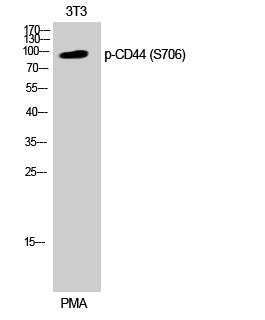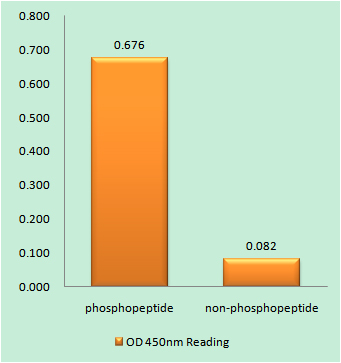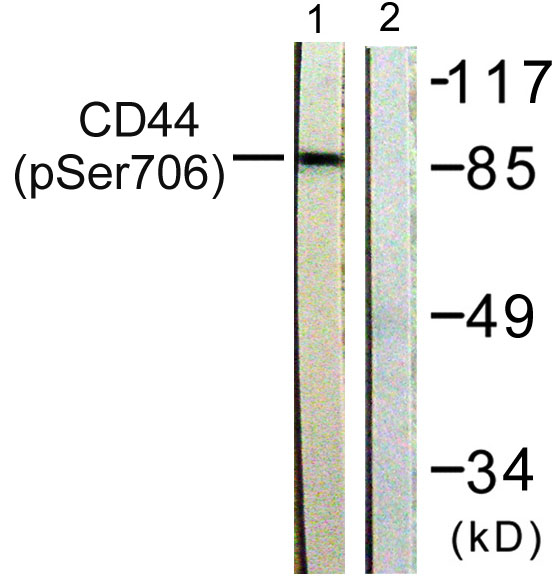CD44 (phospho Ser706) Polyclonal Antibody
- Catalog No.:YP0349
- Applications:WB;ELISA
- Reactivity:Human;Mouse;Rat
- Target:
- CD44
- Fields:
- >>ECM-receptor interaction;>>Hematopoietic cell lineage;>>Shigellosis;>>Epstein-Barr virus infection;>>Proteoglycans in cancer;>>MicroRNAs in cancer
- Gene Name:
- CD44
- Protein Name:
- CD44 antigen
- Human Gene Id:
- 960
- Human Swiss Prot No:
- P16070
- Mouse Gene Id:
- 12505
- Mouse Swiss Prot No:
- P15379
- Rat Swiss Prot No:
- P26051
- Immunogen:
- The antiserum was produced against synthesized peptide derived from human CD44 around the phosphorylation site of Ser706. AA range:681-730
- Specificity:
- Phospho-CD44 (S706) Polyclonal Antibody detects endogenous levels of CD44 protein only when phosphorylated at S706.
- Formulation:
- Liquid in PBS containing 50% glycerol, 0.5% BSA and 0.02% sodium azide.
- Source:
- Polyclonal, Rabbit,IgG
- Dilution:
- WB 1:500 - 1:2000. ELISA: 1:20000. Not yet tested in other applications.
- Purification:
- The antibody was affinity-purified from rabbit antiserum by affinity-chromatography using epitope-specific immunogen.
- Concentration:
- 1 mg/ml
- Storage Stability:
- -15°C to -25°C/1 year(Do not lower than -25°C)
- Other Name:
- CD44;LHR;MDU2;MDU3;MIC4;CD44 antigen;CDw44;Epican;Extracellular matrix receptor III;ECMR-III;GP90 lymphocyte homing/adhesion receptor;HUTCH-I;Heparan sulfate proteoglycan;Hermes antigen;Hyaluronate receptor;Phagocytic glycopr
- Observed Band(KD):
- 90kD
- Background:
- The protein encoded by this gene is a cell-surface glycoprotein involved in cell-cell interactions, cell adhesion and migration. It is a receptor for hyaluronic acid (HA) and can also interact with other ligands, such as osteopontin, collagens, and matrix metalloproteinases (MMPs). This protein participates in a wide variety of cellular functions including lymphocyte activation, recirculation and homing, hematopoiesis, and tumor metastasis. Transcripts for this gene undergo complex alternative splicing that results in many functionally distinct isoforms, however, the full length nature of some of these variants has not been determined. Alternative splicing is the basis for the structural and functional diversity of this protein, and may be related to tumor metastasis. [provided by RefSeq, Jul 2008],
- Function:
- alternative products:Additional isoforms seem to exist. Additional isoforms are produced by alternative splicing of 10 out of 19 exons within the extracellular domain. Additional diversity is generated through the utilization of internal splice donor and acceptor sites within 2 of the exons. A variation in the cytoplasmic domain was shown to result from the alternative splicing of 2 exons. Isoform CD44 is expected to be expressed in normal cells. Splice variants have been found in many tumor cell lines. Exons 5, 6, 7, 8, 9, 10, 11, 13, 14 and 19 are alternatively spliced. Experimental confirmation may be lacking for some isoforms,function:Receptor for hyaluronic acid (HA). Mediates cell-cell and cell-matrix interactions through its affinity for HA, and possibly also through its affinity for other ligands such as osteopontin, collagens, and matrix metalloproteinases (MMPs). Adhesion with
- Subcellular Location:
- Cell membrane ; Single-pass type I membrane protein . Cell projection, microvillus . Colocalizes with actin in membrane protrusions at wounding edges. Co-localizes with RDX, EZR and MSN in microvilli. Localizes to cholesterol-rich membrane-bound lipid raft domains. .
- Expression:
- Isoform 10 (epithelial isoform) is expressed by cells of epithelium and highly expressed by carcinomas. Expression is repressed in neuroblastoma cells.
Afatinib Reverses EMT via Inhibiting CD44-Stat3 Axis to Promote Radiosensitivity in Nasopharyngeal Carcinoma Pharmaceuticals Huichao Huang, Fangling Huang, Xujun Liang, Ying Fu, Zhe Cheng, Yan Huang, Zhuchu Chen, Yankun Duan, Yongheng Chen WB Human 5-8F cell, HNE2 cell
- June 19-2018
- WESTERN IMMUNOBLOTTING PROTOCOL
- June 19-2018
- IMMUNOHISTOCHEMISTRY-PARAFFIN PROTOCOL
- June 19-2018
- IMMUNOFLUORESCENCE PROTOCOL
- September 08-2020
- FLOW-CYTOMEYRT-PROTOCOL
- May 20-2022
- Cell-Based ELISA│解您多样本WB检测之困扰
- July 13-2018
- CELL-BASED-ELISA-PROTOCOL-FOR-ACETYL-PROTEIN
- July 13-2018
- CELL-BASED-ELISA-PROTOCOL-FOR-PHOSPHO-PROTEIN
- July 13-2018
- Antibody-FAQs
- Products Images

- Western Blot analysis of 3T3 cells using Phospho-CD44 (S706) Polyclonal Antibody

- Enzyme-Linked Immunosorbent Assay (Phospho-ELISA) for Immunogen Phosphopeptide (Phospho-left) and Non-Phosphopeptide (Phospho-right), using CD44 (Phospho-Ser706) Antibody

- Western blot analysis of lysates from NIH/3T3 cells treated with PMA 250ng/ml 5', using CD44 (Phospho-Ser706) Antibody. The lane on the right is blocked with the phospho peptide.



